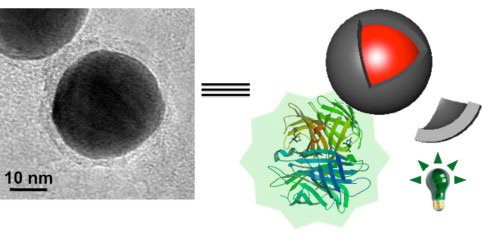| Posted: Apr 28, 2009 | |
Carbon encapsulation of gold nanoparticles increases their stability |
|
| (Nanowerk Spotlight) The use of gold nanoparticles in numerous biological and chemical nanotechnology applications experiences limitations due to the stability of the particles and their tendency for non-specific binding. One method to overcome these problems has been the use of carbon nanoshells to encapsulate gold and other noble metal particles. A graphene-like carbon shell is ideal for surface passivation of the metal nanoparticles for several reasons: it is nonreactive with the metallic surface; it provides unsurpassed stability; and it possesses a convenient handle for functionalization. | |
| The research in graphene or carbon shell growth has been largely focused on utilizing transition metals, such as iron, as catalysts. With regard to gold nanoparticles there has been only limited research. Previously, carbon shells were grown on gold nanoparticles that were dispersed onto a lacey carbon transmission electron microscope (TEM) grid and irradiated with a high intensity electron beam in a TEM at high temperatures. Methods to achieve these materials result in sample sizes limited to the size of the TEM grid. By having such a structure, the materials are likely to possess an increased level of stability in biological media. Unfortunately, by using this method, only a very small sample set could be produced, which was too small for use in real-world applications. | |
| A research team in the U.S. has now demonstrated a new fabrication method to encapsulate gold nanoparticles in a graphene-like carbon shell. | |
| "Ours is a unique methodology where we have utilized surface oxidized gold nanoparticles as catalysts for the growth of the carbon shells with well-controlled thickness employing a chemical vapor deposition (CVD) process," Nitin Chopra tells Nanowerk. "Using this method, an addressable quantity of materials can now be produced in just a few hours." | |
| Chopra, an assistant professor in the Metallurgical and Materials Engineering Department at the University of Alabama is first author of a recent paper in Chemistry of Materials that describes these work ("Fabrication and Biofunctionalization of Carbon-Encapsulated Au Nanoparticles"). | |
| Working with Chopra were two University of Kentucky scientists – Leonidas G. Bachas, Frank J. Derbyshire Professor of Chemistry and Marc R. Knecht also from the Department of Chemistry. | |
 |
|
| TEM image of graphene-like carbon encapsulated gold nanoparticles. Schematic (on right) showing the ability to chemically functionalize such nanoparticles for bioanalysis and sensing applications. (Reprinted with permission from ACS Publications). | |
| The team says that their method, which uses a large area silicon substrate for gold nanoparticle deposition and carbon shell growth, allows them to produce a large enough sample size for different applications where nanoparticle stability is of concern. | |
| By varying the CVD growth conditions, the researchers were able to control the thickness of the carbon shell. However, prolonged growth durations of more than four hours led to rupturing of the carbon shells and their dissociation from the gold core. | |
| The main attraction of these particles lies in bioanalysis and sensing applications as the carbon surface is functionalized in a relatively straight forward manner. This ability can be exploited by many other applications where specific functionalization is key. Additionally, the optical properties of the retained gold nanoparticles can also be used in many optical applications and sensing. | |
| According to the team, the main challenge that remains is scalability and integrating the produced carbon-encapsulated gold nanoparticles into complex chemical and biological analysis and sensing devices. "In this regard, our approach is promising and can be the starting point for the generation of a faster and high-throughput method to prepare these materials," they say. "A solution-based synthetic scheme would also be desirable; however, the methods to achieve this remain undiscovered." | |
 By
Michael
Berger
– Michael is author of three books by the Royal Society of Chemistry:
Nano-Society: Pushing the Boundaries of Technology,
Nanotechnology: The Future is Tiny, and
Nanoengineering: The Skills and Tools Making Technology Invisible
Copyright ©
Nanowerk LLC
By
Michael
Berger
– Michael is author of three books by the Royal Society of Chemistry:
Nano-Society: Pushing the Boundaries of Technology,
Nanotechnology: The Future is Tiny, and
Nanoengineering: The Skills and Tools Making Technology Invisible
Copyright ©
Nanowerk LLC
|
|
|
Become a Spotlight guest author! Join our large and growing group of guest contributors. Have you just published a scientific paper or have other exciting developments to share with the nanotechnology community? Here is how to publish on nanowerk.com. |
|
